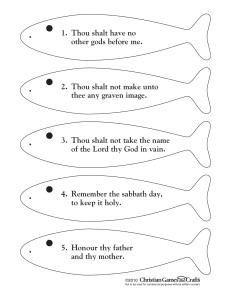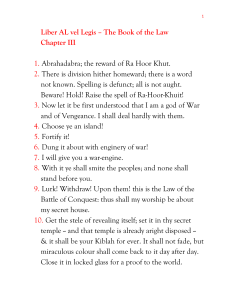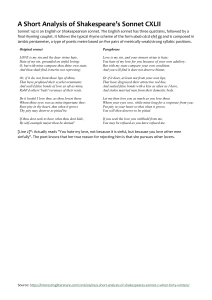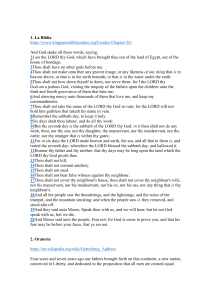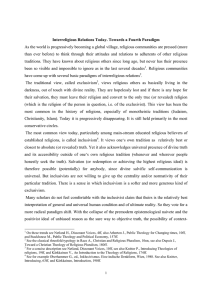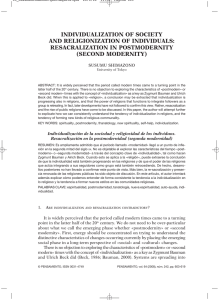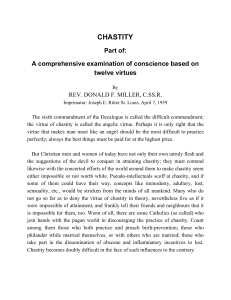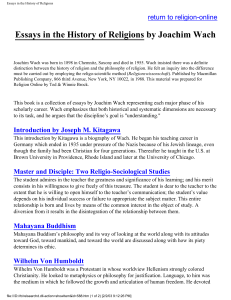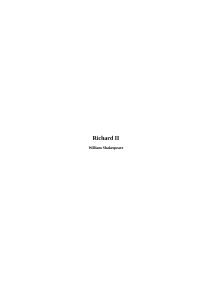Religión en las distintas culturas
Anuncio
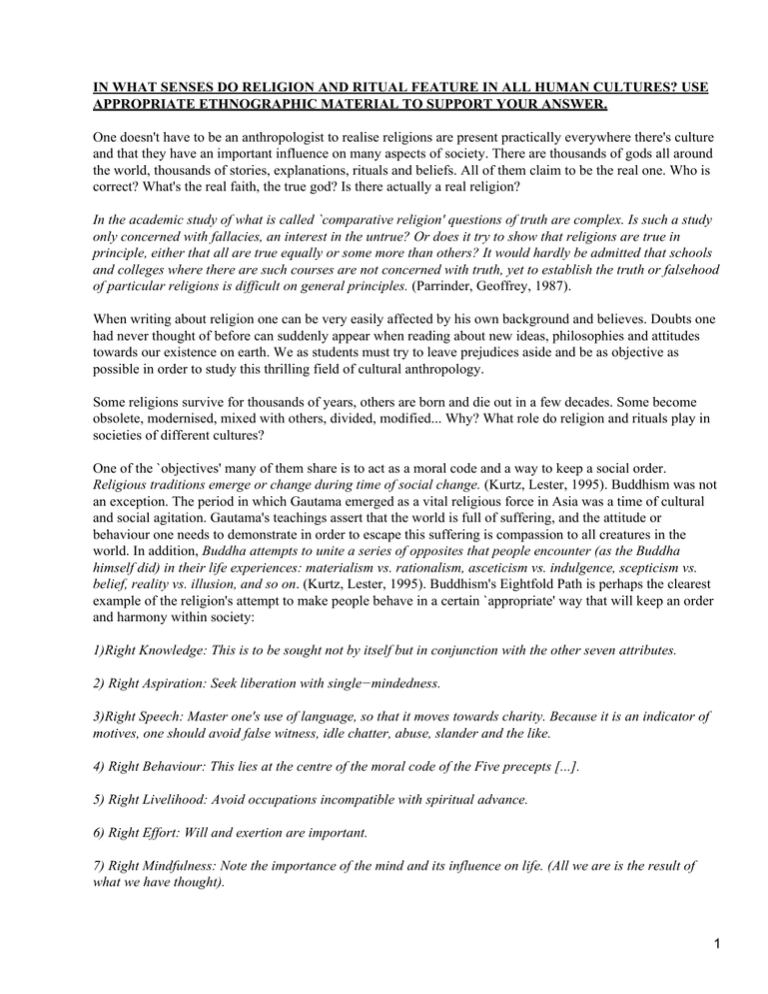
IN WHAT SENSES DO RELIGION AND RITUAL FEATURE IN ALL HUMAN CULTURES? USE APPROPRIATE ETHNOGRAPHIC MATERIAL TO SUPPORT YOUR ANSWER. One doesn't have to be an anthropologist to realise religions are present practically everywhere there's culture and that they have an important influence on many aspects of society. There are thousands of gods all around the world, thousands of stories, explanations, rituals and beliefs. All of them claim to be the real one. Who is correct? What's the real faith, the true god? Is there actually a real religion? In the academic study of what is called `comparative religion' questions of truth are complex. Is such a study only concerned with fallacies, an interest in the untrue? Or does it try to show that religions are true in principle, either that all are true equally or some more than others? It would hardly be admitted that schools and colleges where there are such courses are not concerned with truth, yet to establish the truth or falsehood of particular religions is difficult on general principles. (Parrinder, Geoffrey, 1987). When writing about religion one can be very easily affected by his own background and believes. Doubts one had never thought of before can suddenly appear when reading about new ideas, philosophies and attitudes towards our existence on earth. We as students must try to leave prejudices aside and be as objective as possible in order to study this thrilling field of cultural anthropology. Some religions survive for thousands of years, others are born and die out in a few decades. Some become obsolete, modernised, mixed with others, divided, modified... Why? What role do religion and rituals play in societies of different cultures? One of the `objectives' many of them share is to act as a moral code and a way to keep a social order. Religious traditions emerge or change during time of social change. (Kurtz, Lester, 1995). Buddhism was not an exception. The period in which Gautama emerged as a vital religious force in Asia was a time of cultural and social agitation. Gautama's teachings assert that the world is full of suffering, and the attitude or behaviour one needs to demonstrate in order to escape this suffering is compassion to all creatures in the world. In addition, Buddha attempts to unite a series of opposites that people encounter (as the Buddha himself did) in their life experiences: materialism vs. rationalism, asceticism vs. indulgence, scepticism vs. belief, reality vs. illusion, and so on. (Kurtz, Lester, 1995). Buddhism's Eightfold Path is perhaps the clearest example of the religion's attempt to make people behave in a certain `appropriate' way that will keep an order and harmony within society: 1)Right Knowledge: This is to be sought not by itself but in conjunction with the other seven attributes. 2) Right Aspiration: Seek liberation with single−mindedness. 3)Right Speech: Master one's use of language, so that it moves towards charity. Because it is an indicator of motives, one should avoid false witness, idle chatter, abuse, slander and the like. 4) Right Behaviour: This lies at the centre of the moral code of the Five precepts [...]. 5) Right Livelihood: Avoid occupations incompatible with spiritual advance. 6) Right Effort: Will and exertion are important. 7) Right Mindfulness: Note the importance of the mind and its influence on life. (All we are is the result of what we have thought). 1 8) Right Absorption: Use techniques like those of Raja Yoga. (Kurtz, Lester, 1995). Christianity reflects as well a strong interest in creating a moral code and keeping social order. More than one third of the world's population considers itself follower of the Christian religion, so the interpretations and attitudes towards its teachings vary significantly from culture to culture. Nevertheless, the Ten Commandments remain as perhaps one of the best known moral codes in the history of humanity: I. I Am The Lord Thy God; Thou Shalt Not Have strange gods Before Me. II. Thou Shalt Not Take The Name Of The Lord Thy God In Vain. III. Remember Thou Keep Holy The Sabbath Day. IV. Honour Thy Father And Thy Mother. V. Thou Shalt Not Kill. VI. Thou Shalt Not Commit Adultery. VII. Thou Shalt Not Steal. VIII. Thou Shalt Not Bear False Witness Against Thy Neighbour. IX. Thou Shalt Not Covet Thy Neighbour's Wife. X. Thou Shalt Not Covet Thy Neighbour's Goods. (Exodus 1−17). Moreover, the ideas of Hell, sin and confession can be seen as a way to keep people controlled, reasonably frightened and acting in the `appropriate way'. The Yoruba religion, which has 15 million followers in regions of tropical Africa, imposes also a correct behaviour with respect to elements such as nature and social relations. By using myths and uncomplicated moralistic stories, Yoruba tries to encourage its followers to respect and act responsibly. Once long ago Ile and a heavenly being were hunting. They hunted all day, but all they took was one rodent, and they quarrelled over the prey. When Ile's companion took it with him to heaven, Ile denied her blessing of increase to everything. Green things failed, living things ceased to multiply. All things divine and natural begged the heavenly being to give in. He did so, and Earth relented. (King, Noel Q, 1986). This story of Earth and her powers remind them and us what defiance of Earth and what ecological disaster mean. (King, Noel Q, 1986). Yoruba's god, Olorun−Olodumare, is like a king, commander, director and judge. He cares for everything, yet is remote, calm, balanced in judgement. Like a parent educating a child, Olorun−Olodumare is a paternalistic, powerful figure that expects its followers to show a responsible, good attitude. But religions and rituals can also be used as a tool to gain political power and control. Politics and religion are usually very close together, (even difficult to differentiate in certain cases). In fact, there wasn't actually a difference between these two in Mesopotamia−− they shared the same buildings, people, organisation. Christianity is perhaps the best example for reflecting this alliance politics−religion. It has about 2 billion followers; more people call themselves Christians than identify with any other religious 2 affiliation. Sociologically, the reason for Christianity's dominance of the religious landscape has not been a superior theology but its alliance with the power structures of Western civilisation, first with the Roman Empire after the conversion of powers through the Middle Ages and into the expansionism of the colonial period. In the nineteenth century, colonial and missionary movements spread in tandem from Europe to other parts of the world, conquering land, economic and political resources and cultures. All this power, money and opulence gradually gave place to internal divisions. Christianity's situation started to contradict the Bible's message of humility and modesty and it was in part because of this that ramifications such as Calvinism and Protestantism started to appear. The Yoruba religion is not strongly bonded to politics. In fact, the only example we could set here of people using religion as a way to achieve power is the case in which formulae of words and small objects are thought to be able to trigger the power evoked and be therefore used as a way to gain respect or fear from others. And if there aren't many examples of politics−religion alliance in Yoruba, Buddhism is the great exception. The monks were not priests, nor were they an aristocratic corporation seeking to control politics. [...] They did not care for such worldly things on the whole, but sought to follow the Way and teach the Doctrine. (Parrinder, Geoffrey, 1957). One of the most obvious roles of religion and ritual is being a philosophy, an attempt to explain the unexplainable and adopt an attitude towards life. Historically, religious ideas have provided the major organising principles for explaining the world and defining ethical lives for elites and masses alike, and they continue to do so. [...] When people gather today, the flickering light comes from a television rather than from a fire, but we still hear stories about the nature of reality as it is perceived in our own culture. (Kurtz, Lester, 1995). Buddhism continues to exert a considerable influence both in popular and general culture. We could say it is one of the religions that concentrates the most in concepts and ideas, leaving aside, to a certain extent, supernatural events and beings. Siddhartha's famous enlightenment under the bodhi tree is more like a `meditative climax' than like what other religions would define as a miracle: I thus knew and thus perceived, my mind was emancipated from the asva [canker] of sensual desire, from the asava of desire for existence, and from the asava of ignorance... Ignorance was dispelled, knowledge arose. Darkness was dispelled, light arouse. (Buddha, 1954: 249). The Bible is also a good example for showing how religions convey philosophies and attitudes towards life. In it, Jesus Christ propagates the need for love and forgiving. There is, in addition quite a lot of trying to explain the unexplainable. The Christian concept of the creation of the world in seven days is very well known and has caused a lot of controversy as scientific theories (specially evolution), make of this idea something obsolete for the modern world. Nevertheless, believers of religions such as Yoruba, who usually do not have access to complete education and live surrounded by nature and its direct influence (tropical regions in this case), are the ones who keep the most colourful and interesting attempts to explain the unexplainable through religion. The following myth is a Yoruba version of the creation of the world: When Olodumare and certain divinities resided in the heavens above, the earth was like a marsh wasteland. Heaven and earth were not far apart, and the inhabitants of the above came at times to earth to take their firm land to appear, he called Orisa−nla (Great Divinity) and commanded him to carry out this design. He provided him with some soil, a hen with five toes and a pigeon. Orisa−nla came to earth, threw down the soil, and dry land appeared. When the land was wide and firm enough, Olodumare sent Orisa−nla to place trees upon the earth. The first trees were the palm and three others that provided food, drink, shade and shelter. 3 Olodumare then breathed life into sixteen human beings and sent them to earth. He taught Orisa−nla how to make the forms of human beings, after which Olodumare himself would give them life. (King, Noel Q, 1986). In conclusion, it's easy to see people don't follow religions; it is religions that are made to suit every culture's needs and circumstances. Something to forget our existentialist worries, a tool to obtain power, a way to keep things in order... Where there is society, there is religion and ritual, it might be the price we have to pay for rationality. Bibliography: • King, Noel Q, African Cosmos, USA, Wadsworth Publishing Company, 1986. • Kurtz, Lester, Gods in the Global Village, USA, Pine Forge Press, 1995. • Macmullen, Ramsey, Christianity and Paganism in the Fourth to Eighth Centuries, USA, Yale University Press, 1997. • Parrinder, Geoffrey, Asian religions, Great Britain, Sheldon Press, 1957. • Parrinder, Geoffrey, Encountering World Religions, UK, 1987. • Wach, Joachim, The Comparative Study of Religions, New York, Columbia University Press, 1958. 4
